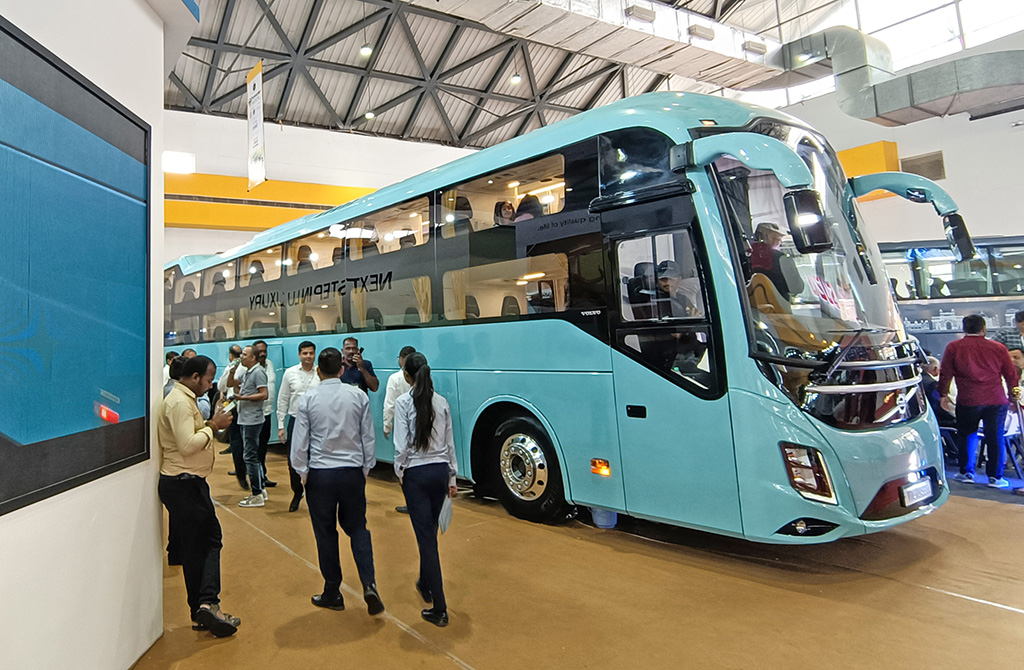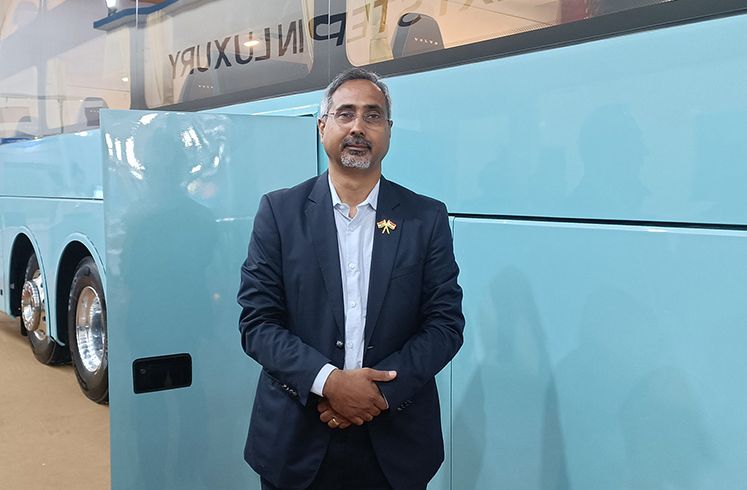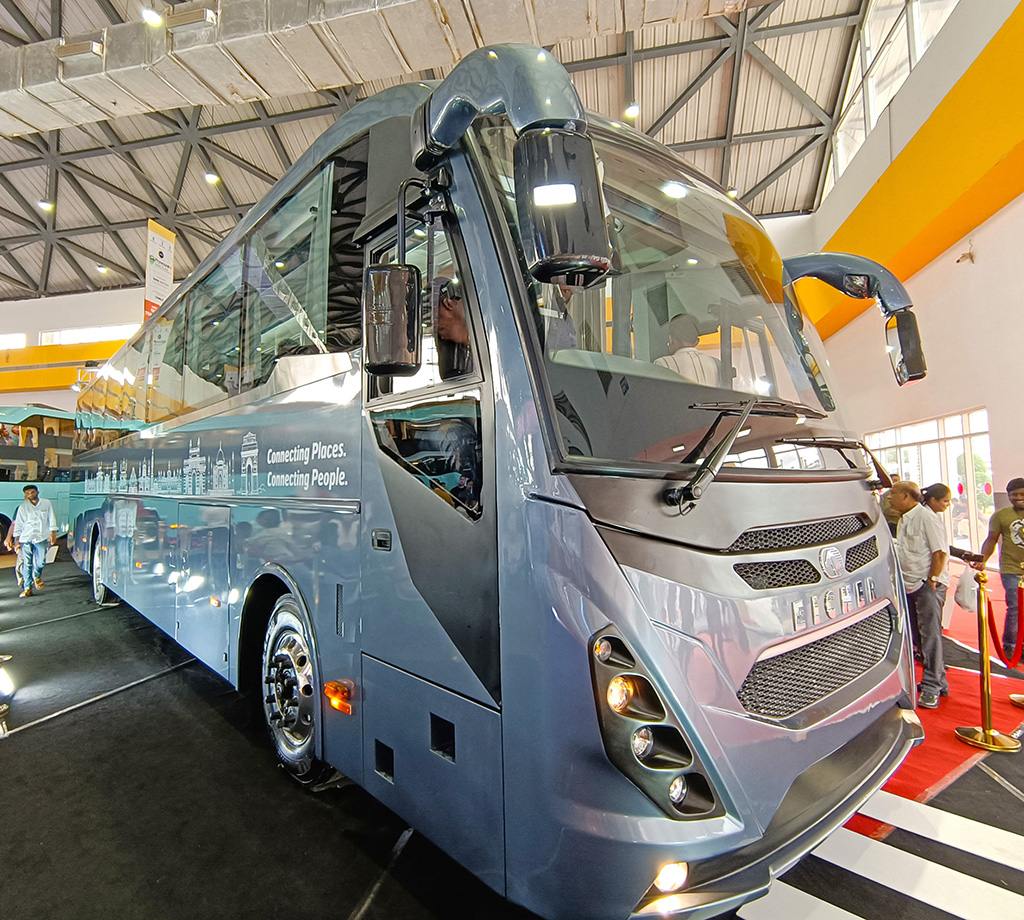
In a conversation with Rajesh Rajgor, Akash Passey, President – Bus Division, VECV, shares that the company’s new intercity coaches are poised to influence the future of the Indian bus industry by improving customer experience on the strength of greater luxury, comfort, and safety
The next-generation Volvo 9600 platform was unveiled at Prawaas by Volvo Buses India, a branch of VE Commercial Vehicles Limited, marking an important turning point in its more than two-decade-old India journey. The initial products on this platform are sleeper and seater coaches with dimensions of 15 m 6×2 and 13.5 m 4×2. The Volvo 9600 is a benchmark in comfort and luxury thanks to its award-winning European design. Fine aesthetics and ample room are combined in the distinctive tall boy design.
The sleeping coach has 40 berths, but the 15-metre seater coach can accommodate 55 passengers. There is 15.1 cubic metres of luggage space in the seater application and 9.2 cubic metres in the sleeper application. Up to 47 people can sit in the 13.5 m coach, while 36 people can sleep in the sleeper version. For the seater and sleeper versions, the corresponding luggage space is 13.6 cubic metres and 8.1 cubic metres, respectively.
Akash Passey, President (Bus Division), VECV, shared the company’s strategy behind a fully built intercity bus in over 20 years of presence in India. He said: “The Indian government established uniform standards two years ago, enabling OEMs like us to produce a sleeper coach. That served as the motivation for this advancement. Any action that complies with the law is what we would like to take. In the past, sleeping buses were not allowed. We take pride in the fact that we are currently the only OEM building a sleeper bus inside our factory in India and delivering a fully built-up sleeper to our clients.”
“While doing so, Volvo always aims to set the bar high and to uphold its commitment to excellence, safety and environmental responsibility. We intended to develop a sleeper that is adored by the industry and especially by those who will be travelling from one area to another because we offer the highest-grade engines with the product,” he added.
Involving Customers
The 9600 product has been an outcome of several discussion with customers. Hence, the response has been very positive. At the heart of the Volvo 9600 platform is the tried, tested, powerful and fuel-efficient Volvo D8K (8-litre) engine, delivering a power of 260 kW (350 hp) at 2,200 RPM and a torque of 1,350 Nm at 1,200-1,600 RPM. The fuel-efficient engine along with its purpose-developed drivetrain is designed to minimise TCO and maximise uptime for bus operators. The chassis includes the I-Shift automated manual gearbox, electronic braking system (EBS), hill start aid and the Electronic Stability Program (ESP) systems.

Akash shared: “Bus operators continue to rely on us to provide solutions that fulfil the desires of intercity passengers for secure, opulent and globally contemporary coaches as the bus industry emerges from a very difficult period. We have improved the air suspension system in terms of safety. The engine area’s noise levels have been further decreased, and the sleeping cabins at the back have been upgraded. These changes will make the bus more comfortable, but also ensure that they will remain firmly anchored to the road even when travelling at high speeds for safety reasons. When the driver is driving, the frontal safety mechanism presents a new car line and a new dashboard that looks like a car.”
He continued: “The driver has a lot clearer perspective thanks to a much longer windscreen. The large side glasses give the impression that the user is riding in a train on a long journey. With plenty of headroom, the commuters may sit and take in the scenery outside. Even if the user isn’t always lying down, he or she can still sit comfortably thanks to the headrest at the rear. Then, of course, we make every effort to employ environmentally friendly materials while building buses. We take efforts to have engines that are not only the most fuel-efficient but also perform at the greatest level in terms of pollution standards. Where Volvo excels is in this area.”
Volvo Eicher Family
In order to cater to the needs of the cost-conscious and no-frill customers, the VECV booth also had the Eicher front engine bus. Akash emphasised: “If you look at any large operator today, 20-30% of their fleet is Volvo but the balance 60-70% of the fleet is still front engine buses. Here is where our Eicher products come in. We have launched the Eicher front engine bus which we have exhibited at the fair in 13.5 m length, both in seater and sleeper versions. For the customers who want that 60-70% of the business and are more cost-conscious than other competitors, they can stay within the same family of all Volvo Eicher Commercial Vehicles. We have buses of different types and that is the thinking with which we are moving to offer whatever our customers need.”
The Eicher 13.5 m intercity coach addresses operators’ demand for a mid-premium HD bus and is the latest addition to the Eicher intercity platform. Proven engine performance, class-leading reliability and improved functionality are some of the hallmarks of the range. The first OEM-built FE coach with seater and sleeper configuration, the bus holds a VEDX5 engine with a power of 240 hp and torque of 900 Nm. Its 425L HDPE fuel tank promises long uninterrupted trips, while its lightweight construction improves fuel efficiency. The sleek tall boy design and layered surfaces of the modern aerodynamics immediately exude aesthetic appeal.
The Eicher Skyline Pro E, a fully electric city bus was also featured by VECV at the event. With orders from the prestigious cities of Chandigarh and Surat in place, the Eicher Skyline Pro E is firmly positioned to offer city bus passengers an emission-free ride.

Market Outlook for 2022
For everyone the pandemic years had been very difficult. The bus industry, in particular, took a big hit because of the lockdowns. Therefore, to see the market bouncing back is really a pleasure. The light and medium duty bus market came back about four-five months back. The intercity long-distance market will now be back from August. “We have lived the first four months of this financial year primarily on our Eicher business with school buses where we have 30-40% market share in India. It was followed by the staff buses, route permit and stage carriage buses. These have primarily delivered the volumes. It has been great so far,” Akash said.
“We have sold almost over 5,000 vehicles in the first four months. It is a substantial growth as we have sold much more than what we did in the last one year. It will take a year or two to normalise and go back to the pre-pandemic times. Light and medium duty vehicles have started in the right direction. Heavy duty and intercity will come in now. So, our outlook is really very positive. We have offered the full plethora of options to our customers so that when they are now, after two three years, discussing business with us, we are sure they would buy from us considering we offer one-stop solutions, right from school buses, staff transportation, electric to intercity coaches,” he summed up.